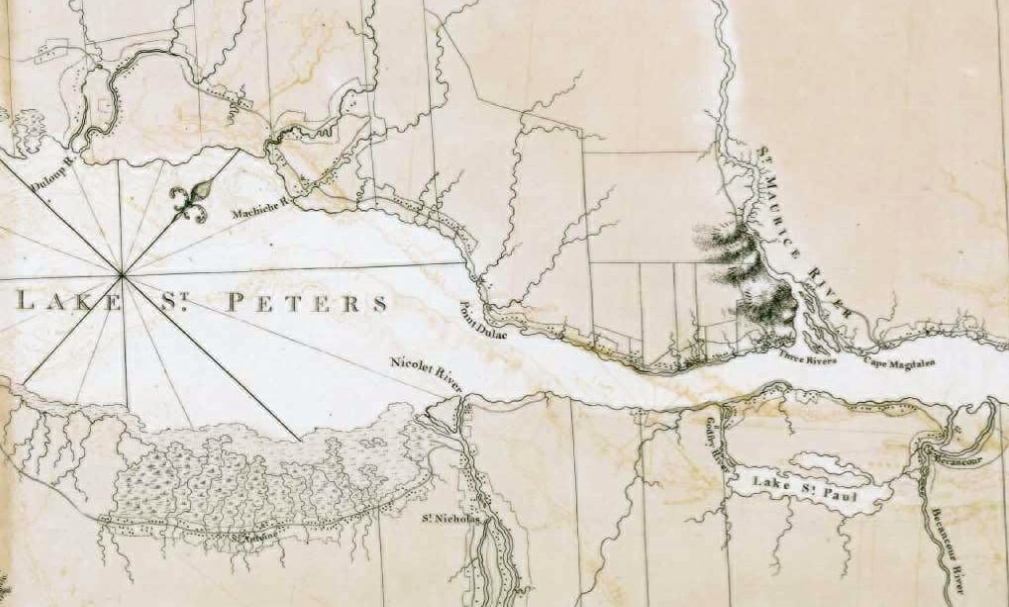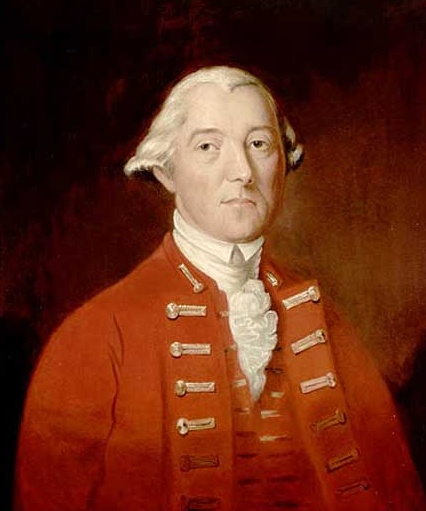|
Battle Of Trois-Rivières
The Battle of Trois-Rivières was fought on June 8, 1776, during the American Revolutionary War. A British army under Quebec Governor Guy Carleton defeated an attempt by units from the Continental Army under the command of Brigadier General William Thompson to stop a British advance up the Saint Lawrence River valley. The battle occurred as a part of the American colonists' invasion of Quebec, which had begun in September 1775 with the goal of removing the province from British rule. The crossing of the Saint Lawrence by the American troops was observed by Quebec militia, who alerted British troops at Trois-Rivières. A local farmer led the Americans into a swamp, enabling the British to land additional forces in the village, and to establish positions behind the American army. After a brief exchange between an established British line and American troops emerging from the swamp, the Americans broke into a somewhat disorganized retreat. As some avenues of retreat were cut off, ... [...More Info...] [...Related Items...] OR: [Wikipedia] [Google] [Baidu] |
Trois-Rivières
Trois-Rivières (, ; ) is a city in the Mauricie administrative region of Quebec, Canada. It is located at the confluence of the Saint-Maurice River, Saint-Maurice and Saint Lawrence River, Saint Lawrence rivers, on the north shore of the Saint Lawrence River across from the city of Bécancour, Quebec, Bécancour. It is part of the densely populated Quebec City–Windsor Corridor and is approximately halfway between Montreal and Quebec City. Trois-Rivières is the economic and cultural hub of the Mauricie region. The settlement was founded by French colonists on July 4, 1634, as the second permanent settlement in New France, after Quebec City in 1608. The name of Trois-Rivières, which dates from the end of the 16th century, was used by French explorers in reference to the three channels in the Saint-Maurice River formed at its mouth with the Saint Lawrence, as it is divided by two islands, Potherie (Île Caron) and Saint-Quentin Island, Île Saint-Quentin. The city occupies a ... [...More Info...] [...Related Items...] OR: [Wikipedia] [Google] [Baidu] |
John Sullivan (general)
Major-General John Sullivan (February 17, 1740 – January 23, 1795) was a Continental Army officer, politician and judge who fought in the American Revolutionary War and participated several key events of the conflict, including most notably George Washington's crossing of the Delaware River. He was also a delegate to the Continental Congress, where Sullivan signed the Continental Association. After the war, he served as the third governor of New Hampshire and was appointed as a United States district judge of the United States District Court for the District of New Hampshire. Sullivan, the third son of American settlers, commanded the Sullivan Expedition in 1779, a scorched earth by the Continental Army which destroyed 40 Iroquois villages, leading to the forced displacement of 5,000 Iroquois as refugees to British controlled Fort Niagara and the deaths of several hundred Iroquois during the harsh winter of 1779–1780. As a member of Congress, Sullivan worked closely with ... [...More Info...] [...Related Items...] OR: [Wikipedia] [Google] [Baidu] |
List Of Regiments Of Foot
This is a list of numbered regiments of foot of the British Army from the mid-18th century until 1881, when numbering was abandoned. ''Foot'' was the contemporary term for ''infantry''. Introduction Rank and numbering Establishment of precedence The rank of regiments of the English Army was first fixed during the Nine Years' War. Doubts as to the respective rank of regiments fighting in the Spanish Netherlands led William III to command a Board of General Officers meeting on 10 June 1694 to establish the order of precedence of the various units. With the union of the kingdoms of England and Scotland to form the Kingdom of Great Britain in 1707 the British Army came into existence (see Creation of British Army). The order of seniority for the most senior line regiments in the British Army is based on the order of seniority in the English army. Scottish and Irish regiments were only allowed to take a rank in the English army from the date of their arrival in England or the da ... [...More Info...] [...Related Items...] OR: [Wikipedia] [Google] [Baidu] |
King's Royal Rifle Corps
The King's Royal Rifle Corps was an infantry rifle regiment of the British Army that was originally raised in British North America as the Royal American Regiment during the phase of the Seven Years' War in North America known in the United States as 'The French and Indian War.' Subsequently numbered the 60th Regiment of Foot, the regiment served for more than 200 years throughout the British Empire. In 1958, the regiment joined the Oxfordshire and Buckinghamshire Light Infantry and the Rifle Brigade (Prince Consort's Own), Rifle Brigade in the Green Jackets Brigade and in 1966 the three regiments were formally amalgamated to become the Royal Green Jackets. The KRRC became the 2nd Battalion, Royal Green Jackets. On the disbandment of the 1st Battalion, Royal Green Jackets in 1992, the RGJ's KRRC battalion was redesignated as the 1st Battalion, Royal Green Jackets, eventually becoming 2nd Battalion, The Rifles in 2007. History French and Indian War The King's Royal Rifle Corps w ... [...More Info...] [...Related Items...] OR: [Wikipedia] [Google] [Baidu] |
53rd Regiment Of Foot
The ''53rd (Shropshire) Regiment of Foot was a British Army regiment, raised in 1755. Under the Childers Reforms it amalgamated with the 85th (King's Light Infantry) Regiment of Foot to form the King's Shropshire Light Infantry in 1881. History Early history The regiment was raised in Northern England by Colonel William Whitmore as the 55th Regiment of Foot for service in the Seven Years' War. It was re-ranked as the 53rd Regiment of Foot, following the disbandment of the existing 50th and 51st regiments, in 1756. The regiment embarked for Gibraltar in 1756 and, after returning home, moved to Ireland in 1768.Cannon, p. 3 American Revolutionary War The regiment departed Ireland for North America in April 1776 and arrived at Quebec City in May 1776 to help raise the siege of the city by Continental Army troops during the American Revolutionary War. It served under Sir Guy Carleton at the Battle of Trois-Rivières in June 1776 and the Battle of Valcour Island in October 17 ... [...More Info...] [...Related Items...] OR: [Wikipedia] [Google] [Baidu] |
29th Regiment Of Foot
The 29th (Worcestershire) Regiment of Foot was an infantry regiment of the British Army, raised in 1694. Under the Childers Reforms it amalgamated with the 36th (Herefordshire) Regiment of Foot to become the 1st Battalion, the Worcestershire Regiment in 1881. History Formation in 1694 to end of the 18th Century The regiment was formed on 16 February 1694 during the Nine Years War by Colonel Thomas Farrington as Thomas Farrington's Regiment of Foot. Disbanded after the 1697 Treaty of Ryswick, it was reformed in 1702 when the War of the Spanish Succession began; while intended for the West Indies, a notoriously unhealthy posting, Farrington's protests meant that instead it joined Marlborough's army in Flanders in 1704. Too late for the Blenheim campaign, it fought at the Battle of Ramillies in May 1706 and the Siege of Ostend in June. Lord Mark Kerr became Colonel when Farringdon died in October 1712, but, with the war winding down, it became part of the Gibraltar garrison. ... [...More Info...] [...Related Items...] OR: [Wikipedia] [Google] [Baidu] |
John Thomas (general)
John Thomas (1724 – 2 June 1776) was an American medical doctor and soldier from Massachusetts who became a major general in the Continental Army. He was a leader during the siege of Boston. Thomas briefly commanded the withdrawal from Canada after the unsuccessful invasion by the Continental Army. He died from smallpox during the retreat. Early life Thomas was born in Marshfield, Province of Massachusetts Bay. As a young man he studied medicine with Doctor Tufts in Medford before beginning his own practice in Kingston. He was married to Hannah Thomas with whom he had two sons and a daughter. Colonial wars During King George's War in 1746 he was appointed surgeon to a regiment bound for Annapolis Royal in Nova Scotia. Liking military service, in 1747 he traded his post as surgeon for that of a lieutenant. In 1755 he served as surgeon in General William Shirley's regiment. By the time of the French and Indian War he had risen to colonel in the militia or provincial ranks ... [...More Info...] [...Related Items...] OR: [Wikipedia] [Google] [Baidu] |
Royal Navy
The Royal Navy (RN) is the naval warfare force of the United Kingdom. It is a component of His Majesty's Naval Service, and its officers hold their commissions from the King of the United Kingdom, King. Although warships were used by Kingdom of England, English and Kingdom of Scotland, Scottish kings from the early Middle Ages, medieval period, the first major maritime engagements were fought in the Hundred Years' War against Kingdom of France, France. The modern Royal Navy traces its origins to the English Navy of the early 16th century; the oldest of the British Armed Forces, UK's armed services, it is consequently known as the Senior Service. From the early 18th century until the World War II, Second World War, it was the world's most powerful navy. The Royal Navy played a key part in establishing and defending the British Empire, and four Imperial fortress colonies and a string of imperial bases and coaling stations secured the Royal Navy's ability to assert naval superior ... [...More Info...] [...Related Items...] OR: [Wikipedia] [Google] [Baidu] |
Stanley
Stanley may refer to: Arts and entertainment Film and television * ''Stanley'' (1972 film), an American horror film * ''Stanley'' (1984 film), an Australian comedy * ''Stanley'' (1999 film), an animated short * ''Stanley'' (1956 TV series), an American situation comedy * ''Stanley'' (2001 TV series), an American animated series Other uses in arts and entertainment * ''Stanley'' (play), by Pam Gems, 1996 * Stanley Award, an Australian Cartoonists' Association award * '' Stanley: The Search for Dr. Livingston'', a video game Businesses * Stanley, Inc., an American information technology company * Stanley Aviation, an American aerospace company * Stanley Black & Decker, formerly The Stanley Works, an American hardware manufacturer ** Stanley Hand Tools, a division of Stanley Black & Decker * Stanley bottle, a brand of food and beverage containers * Stanley Electric, a Japanese manufacturer of electric lights * Stanley Furniture, an American furniture manufacturer * ... [...More Info...] [...Related Items...] OR: [Wikipedia] [Google] [Baidu] |
Benedict Arnold
Benedict Arnold (#Brandt, Brandt (1994), p. 4June 14, 1801) was an American-born British military officer who served during the American Revolutionary War. He fought with distinction for the American Continental Army and rose to the rank of major general before defecting to the British in 1780. General George Washington had given him his fullest trust and had placed him in command of West Point, New York, West Point in New York Colony, New York. Arnold was planning to surrender the fort to British forces, but the plot was discovered in September 1780, whereupon he fled to the British lines. In the later part of the war, Arnold was commissioned as a brigadier general in the British Army during the American Revolutionary War, British Army and placed in command of the American Legion (Great Britain), American Legion. He led British forces in battle against the army which he had once commanded, and his name became synonymous with treason and betrayal in the United States.#Rogets, ... [...More Info...] [...Related Items...] OR: [Wikipedia] [Google] [Baidu] |






